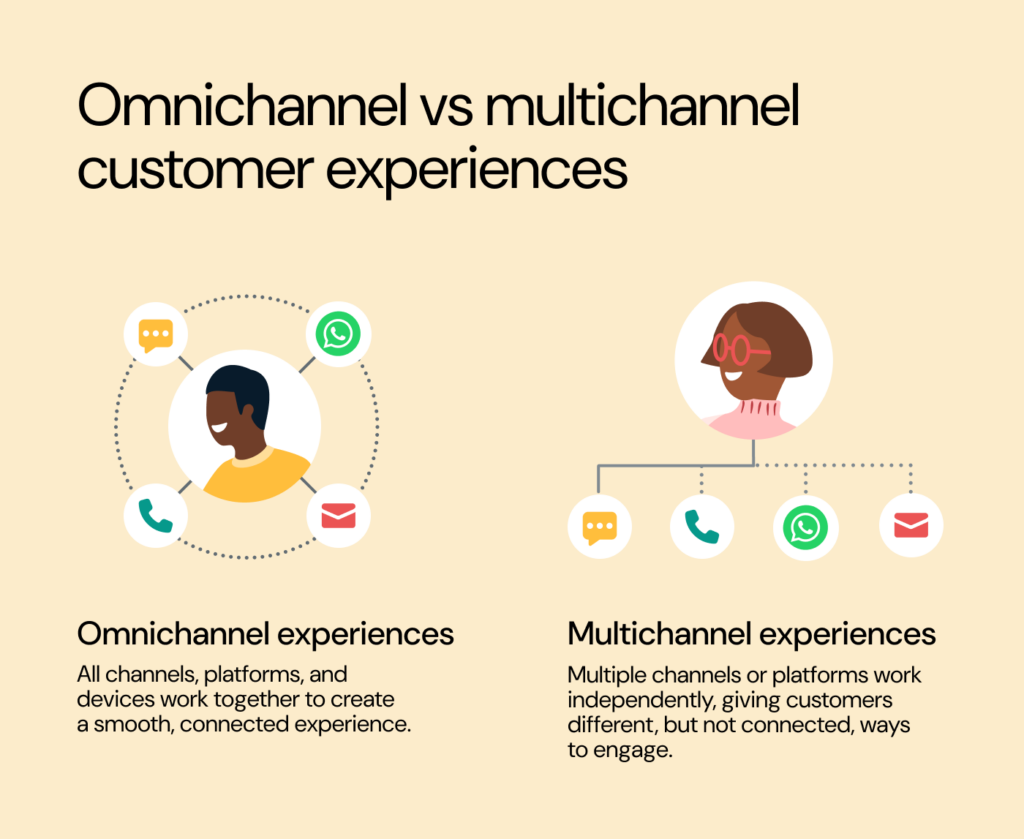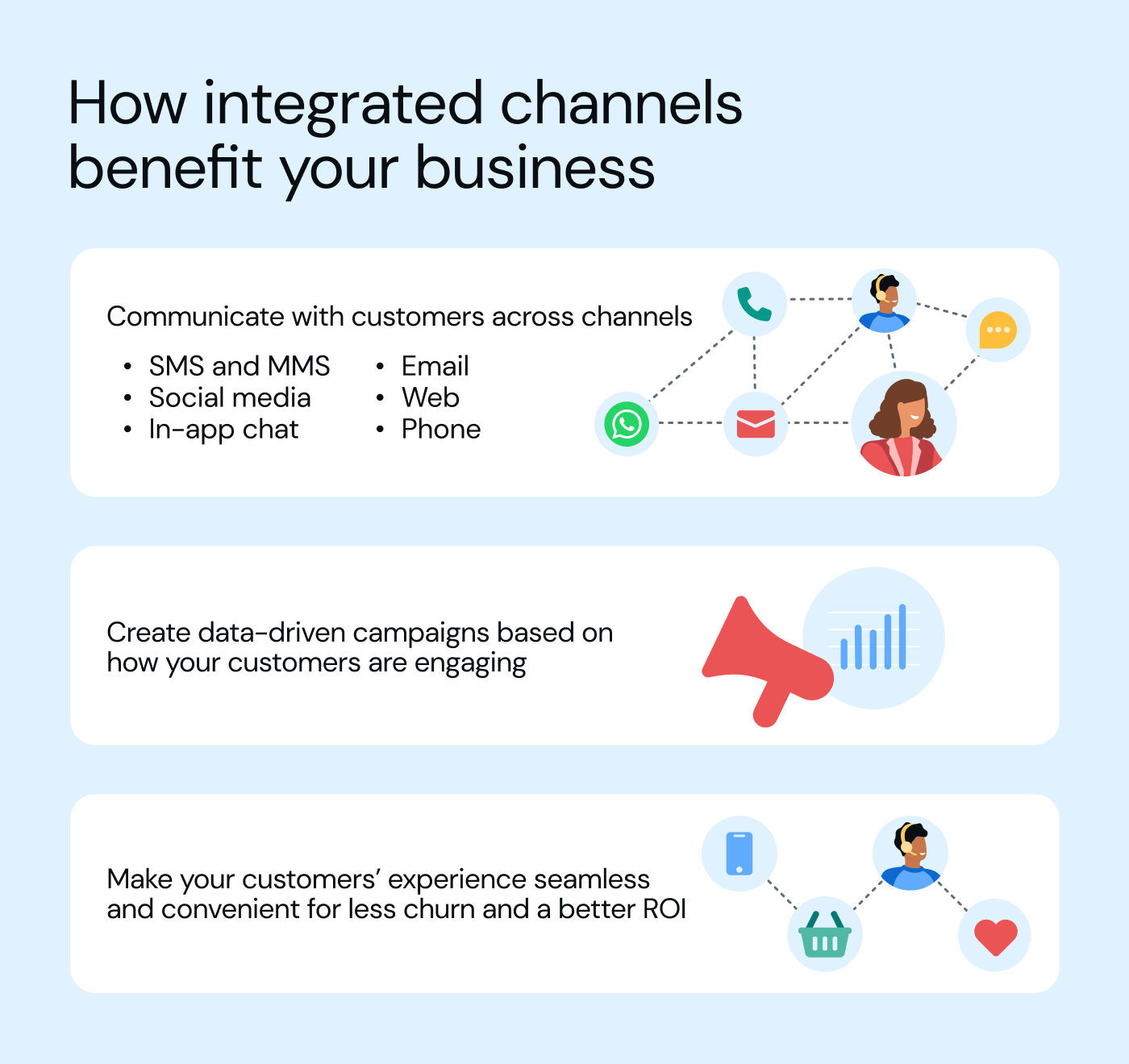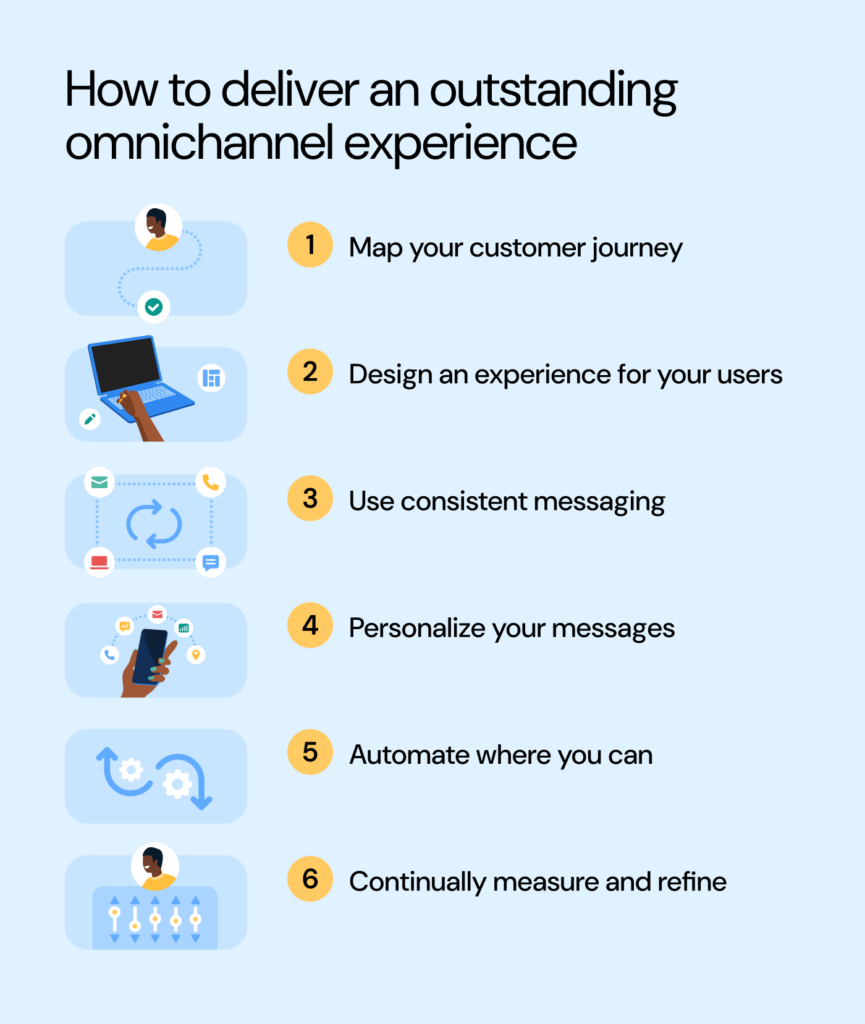Insights
How to build an omnichannel experience customers will love

Insights

You’re scrolling through Instagram, eyeing a sleek pair of sneakers. Later, you spot them in a store window and decide to try them on. The next day, you get an email with a discount code for those exact shoes.
Coincidence? Not quite.
Welcome to the world of omnichannel marketing, where your shopping journey is as seamless as it is personal. It’s a world where brands seem to read your mind, anticipating customer needs across every platform.
But for businesses, creating this magic isn’t easy. It’s a delicate dance of strategy, technology, and customer understanding.
In this article, we’ll cover what an omnichannel experience is, list its benefits, provide tips on how to create it, and share examples from real brands to help you execute it.
An omnichannel experience is a holistic approach to customer interaction that creates an integrated journey across all customer touchpoints.
It’s when customers can effortlessly switch between various channels a business operates, including chatbots, live chat, SMS/MMS, messaging apps, voice, and social media, without losing their place or needing to repeat information.
This approach helps brands build deeper relationships that boost customer retention and revenue.
It extends beyond marketing and support to include sales and service and ensures consistency across all customer interactions, regardless of where customers interact with the brand.
The difference between businesses that provide an omnichannel vs multichannel experience to customers is key: While multichannel allows interaction across multiple platforms, those platforms often don’t communicate with each other. Meanwhile, omnichannel unifies those platforms into a seamless experience.

Multichannel marketing focuses on expanding reach through various channels, but these channels often operate independently. An omnichannel approach, however, is more customer-centric.
Omnichannel’s advantage comes from its integrated infrastructure that shares customer data across platforms. No matter where the interaction occurs, the brand has full context and functionality to reduce friction and improve customer satisfaction.
With omnichannel, customers can start on their laptop, continue on a mobile device, and complete their purchase in the store – all while enjoying a consistent experience. This integrated approach leads to higher customer satisfaction and loyalty compared to the more fragmented multichannel marketing approach.
To stay competitive, brands must shift to an omnichannel strategy that puts customer experience at the forefront.
Customers now expect an omnichannel experience, not just prefer it. Our Customer Connections research shows that consumers use different channels at varying stages of their journey and adapt their communication preferences based on current needs and context.
While 36% of customers prefer email for pre-purchase communication, mobile messaging channels lead the way for initial interactions at 43%.

Channel preferences vary throughout the customer lifecycle, from order confirmations to support and identity verification.
Today’s customers demand control over their brand interactions. They want the flexibility to switch channels, consume third-party content, and engage with companies in ways that fit naturally into their daily lives.
This expectation for a cohesive experience across touchpoints is evident in the growing popularity of rich messaging channels like Rich Communication Services (RCS), MMS, WhatsApp, and Apple Messages for Business, accounting for 25% of consumer preferences.
Businesses are taking note, with 36% already using these innovative channels to interact with new subscribers. By embracing an omnichannel approach, brands can deliver valuable, cohesive experiences that foster lasting connections and meet the evolving expectations of modern consumers.
An omnichannel customer experience presents your brand as one entity. Regardless of how many brick-and-mortar stores or digital channels you’re operating on.
There are plenty of benefits of this, including:

So how do you actually create an omnichannel experience? Here are six crucial steps:
Identify all the touchpoints where customers interact with your business across different channels, from initial awareness to post-purchase customer support.
Creating a customer journey map ensures you’re delivering a unified experience, no matter where the customer is engaging with your brand.
Track how customers find your brand, whether through social media, search engines, or word-of-mouth. Pay close attention to how they move between channels through consideration, purchase, and beyond. For example, they might research on their phone but buy on their computer. Watch for pain points and chances to optimize at every step.
Once you’ve identified key touchpoints and pain points, prioritize areas where friction is highest and implement targeted solutions, like streamlining checkout across devices or simplifying support channels.
Focusing on this journey in detail helps you learn more about how your customers behave and what they like. This knowledge allows you to create a smooth experience that meets their needs at every step.
Here’s a hard truth: More channels don’t always equal a better experience. Focus on quality over quantity.
Why? Because customers care more about seamlessness and simplicity than about the number of channels you’re on.
Put your users front and center when designing your omnichannel strategy. Don’t fall into the trap of adding channels just because they’re trendy or your competitors are using them. Instead, concentrate on the platforms where your customers actually spend their time and prefer to interact with brands like yours.
Analyze your customer data from your customer relationship management software (CRM). Which channels are driving the most engagement? Where are your customers reaching out for support? Use these insights to prioritize your efforts and resources.
For example, if customer data shows higher engagement on Instagram but more conversions from email, focus your creative energy on Instagram for awareness and use email for closing sales.
Create a cohesive experience that feels natural and convenient for your users. This could mean a strong Instagram presence paired with live chat support, especially if targeting younger audiences. Or it could involve focusing on email and phone support for a B2B audience.
Design an experience that feels personalized and valuable – not overwhelming.
Make sure your brand voice, messaging, and service stay consistent, whether a customer is on your website, talking to support, or engaging with your social media.
Your messaging should be recognizably “you” across all platforms, but it also needs to flex and adapt to each channel’s unique characteristics and audience expectations.
Think of your brand voice as adaptable – consistent in its core but flexible enough to suit the tone of each platform, like LinkedIn’s professionalism or TikTok’s playfulness.
But different segments of your customer base might prefer different types of content or respond better to certain tones. Use your customer data to understand these preferences and tailor your messaging accordingly.
Keep your brand values and key messages consistent, but experiment with different ways of expressing them across channels. Consistency builds trust and makes it easier for customers to recognize and connect with your brand, no matter where they encounter it.
Customers expect a personalized user experience. And they’re willing to walk away if you don’t meet this expectation.
According to our Customer Connections report, 25% of people said that “irrelevant communications” is a dealbreaker.

That’s right – one in four customers might jump ship if you’re not hitting the mark with your messaging.
So, how do you avoid this pitfall?
Personalization goes beyond just slapping a customer’s name at the top of an email. Use the data you have to create truly relevant, tailored content. Consider their:
Use these insights to create messages that resonate on a personal level. For example, a fashion retailer might send style recommendations based on past purchases, or a SaaS company could offer tips relevant to a customer’s specific use case.
Automation tools help here. Use them to trigger personalized messages based on customer actions, like abandoned cart reminders or tailored product recommendations.
When you nail this, you’re building lasting customer relationships that drive loyalty and growth.
Automation amplifies your omnichannel strategy. But before you start picturing an army of soulless robots, let’s break it down.
According to our Customer Connections report, 45% of people are actually open to using chatbots to get their questions answered.
Why? Because when done right, automation can provide quick, efficient service around the clock.
Beyond customer service, automation accelerates campaign creation. AI-powered tools generate content tailored to your brand voice and audience across multiple languages to save time and resources.
Message analysis is another great automation tool. It gives you insights into your omnichannel customer journeys and intent, helping you personalize and add context to conversations.
At the same time, maintain a human touch. Always provide an option for customers to switch to a live agent if needed. This balance between automation and human interaction ensures efficient service delivery while addressing complex queries that require a personal touch.
Your omnichannel strategy isn’t a “set it and forget it” deal. It’s a living, breathing approach that needs constant attention and tweaking.
Set up key performance indicators (KPIs) for each channel and touchpoint. Track metrics like customer satisfaction scores, conversion rates, and engagement levels across platforms. Pay attention to how customers move between channels and where they might be dropping off.
These KPIs provide a roadmap to understanding what’s working and where you need to refine your approach to meet customer expectations.
Use tools like customer surveys, social listening, and analytics platforms to gather both quantitative and qualitative data. This information is gold – it tells you what’s working and what’s not.
It’s also important to experiment. Experimentation lets you stay ahead of changing customer behaviors and ensures you’re always offering the best possible experience.
Try A/B testing different messaging or user flows. Maybe your Instagram audience responds better to video content, while your email subscribers prefer long-form articles.
Stay flexible and responsive. As customer preferences evolve and new channels emerge, your omnichannel strategy should evolve too.

What does an omnichannel brand experience actually look like in practice? Here’s how some of the biggest brands in the world do it.
E-commerce giant, Amazon, recognizes and caters to customers across multiple touchpoints, whether they’re browsing on a laptop, shopping via mobile app, or even chatting with Alexa on their Echo device.
Log into your account, and Amazon instantly recognizes you, tailoring the experience accordingly – browse a product on your phone, and it’ll show up in your recently-viewed items on your desktop. Add something to your cart on the website and Alexa can help you complete the purchase on your phone later.
From personalized recommendations on your homepage to real-time cart syncing across devices, Amazon ensures that each step in your shopping journey is tailored to your behavior.
This transfer extends to Amazon’s offline stores, too. In Amazon Go stores, for example, you can walk in, grab what you need, and walk out – with the purchase automatically charged to your Amazon account.
This level of integration makes Amazon’s omnichannel experience feel less like separate channels and more like one cohesive journey.
Apple creates a unified ecosystem that feels intuitive, regardless of where or how customers interact with the brand.
At the heart of Apple’s omnichannel strategy is the Apple ID. This single sign-on system (SSO) builds a consistent journey across all touchpoints. Start browsing for a new iPhone on Apple’s website, and continue your research on the Apple Store app.
Ready to make a purchase? Buy online and pick up in-store, where a specialist helps you set up your new device.
Even after purchase, the omnichannel experience continues with personalized help from the Apple Support app, tailored to your devices. And you can easily schedule Genius Bar appointments at your local Apple Store.
What’s impressive is how their in-person locations act as extensions of the digital presence. The stores are community hubs where customers can attend workshops, get support, or simply experience products firsthand.
This approach ensures that whether you’re online, in-app, or in-store, you’re always immersed in the Apple ecosystem, enjoying premium and personalized support.
BofA integrates its mobile app, website, and in-branch services, allowing customers to start a transaction online, get real-time updates via the app, and receive personalized assistance at a branch.
For example, start a loan application on your phone, then pick up right where you left off on your desktop.
Need more help? Schedule an appointment with a specialist at your local branch, directly from the app. When you arrive, the banker already has your information at hand, thanks to the data integration across channels.
This smooth syncing makes it easy to manage complex banking tasks from anywhere, saving time and enhancing convenience.
They’ve also taken omnichannel a step further with features like cardless ATM access via smartphone and integration with virtual assistants like Erica. This AI-powered assistant can help with everything from transaction lookups to budgeting advice, learning from your behavior across all channels to provide custom financial guidance.
This mix of digital convenience and personal expertise shows how Bank of America redefines omnichannel banking, ensuring customers have access to the services they need, however they choose to engage.
Spotify creates a personalized experience that follows users across devices and platforms.
Its omnichannel strategy centers around its powerful recommendation engine. Whether you’re on your smartphone, desktop, smart speaker, or car audio system, Spotify remembers your preferences and listening history.
Spotify creates tailored playlists like “Discover Weekly” and “Daily Mix,” which adapt to your tastes over time. The platform also offers year-end roundups with “Spotify Wrapped,” which creates shareable content and boosts engagement across social media.
No matter how or where you access the service, it’s always uniquely you.
Customers want smooth interactions across all touchpoints, whether they’re on your website, social media, or visiting your store.
But managing these channels can be tricky. With CPaaS, you can unify your communication channels, personalize interactions, and gather data to keep improving your strategy. It’s what turns a disconnected multichannel approach into a seamless omnichannel experience.
Here’s how Sinch’s APIs can add real-time communication to your apps.
With these tools, create a seamless omnichannel experience and reach your customers with the right message at the right time and place. The result? Happier customers, more customer loyalty, and a healthier bottom line.